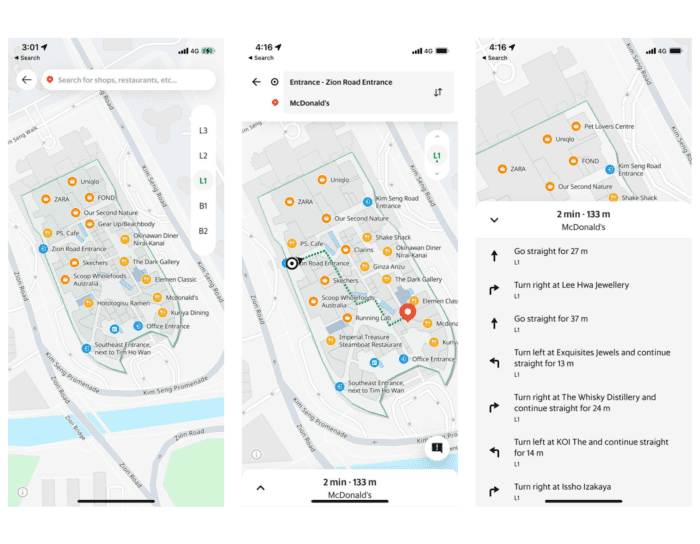Maybe it’s the convenience of having everything in one place; maybe it’s the air conditioning providing relief from the tropical weather.
Whatever the reason, malls are central to Southeast Asia’s urban life. The region hosts some of the largest malls in the world. The Central World Mall in Bangkok, Thailand, for instance, spans seven floors and 5.9 million square feet – that’s about 100 football fields or more than 400 Olympic-size pools.
Fun for shoppers, but not so much for our driver-partners who are in a rush to pick up deliveries. They often have to navigate these large shopping malls and retail complexes to get to the outlets of our food and beverage (F&B) merchant-partners.
To help driver-partners find their way, we developed Indoor Maps.
Mapmaking’s next frontier: the great indoors
We got feedback from driver-partners who face challenges locating F&B outlets in malls they’re unfamiliar with. It can be frustrating getting lost trying to find a restaurant inside a large, multi-level building. It’s time-consuming, too, which means they could end up making fewer deliveries.
(Read more: A round-up of productivity tools for drivers)
To help them get to pick-up points faster and improve their overall efficiency—which translates to more jobs completed and potentially higher take-home pay—we brought mapmaking indoors and started mapping Southeast Asia’s malls.
How we built Indoor Maps
We worked with over 40 malls in six countries across Southeast Asia to create an indoor directory within the Grab app. The malls gave us blueprints of their buildings, and we used our proprietary tools to digitise these blueprints and connect them with our existing services.
Some popular malls we currently cover are KLCC and Pavillion in Malaysia, Jurong Point in Singapore, Central Mall Ladprao in Thailand, and UP Town Center in the Philippines.
How it works
Driver-partners can input their current location and destination into their app and get a turn-by-turn route mapped out for them. Whereas road maps typically tell users to turn after a certain distance, Indoor Maps instruct driver-partners to turn at specific stores.
The walking guide lets them scroll through the directions, which changes the app’s view to show where they need to go next. A cross-level feature allows users to view and navigate a building’s different levels, helping them figure out which escalator or elevator to take.

The result? Faster walking times, faster deliveries
Indoor Maps enable driver-partners to cut their walking times short and reduce the likelihood of getting lost in a mall. So far, drivers who used Indoor Maps spent up to 20.4 per cent less time looking for a restaurant compared to those who didn’t.
(Read more: How we cut down the time delivery-partners wait at food outlets)
Next steps
Mapmaking is continuous work. Stores can shutter, renovate, or move locations. To keep Indoor Maps relevant, we receive constant updates from driver-partners who give us feedback on store closures or issues with the suggested routes they’re getting.
This year, we hope to expand our coverage to more malls and retail complexes across the region. Next on our plate is rolling out Indoor Maps for wet markets in Malaysia, something we’re already working on.
3 Media Close,
Singapore 138498
Komsan Chiyadis
GrabFood delivery-partner, Thailand
COVID-19 has dealt an unprecedented blow to the tourism industry, affecting the livelihoods of millions of workers. One of them was Komsan, an assistant chef in a luxury hotel based in the Srinakarin area.
As the number of tourists at the hotel plunged, he decided to sign up as a GrabFood delivery-partner to earn an alternative income. Soon after, the hotel ceased operations.
Komsan has viewed this change through an optimistic lens, calling it the perfect opportunity for him to embark on a fresh journey after his previous job. Aside from GrabFood deliveries, he now also picks up GrabExpress jobs. It can get tiring, having to shuttle between different locations, but Komsan finds it exciting. And mostly, he’s glad to get his income back on track.

